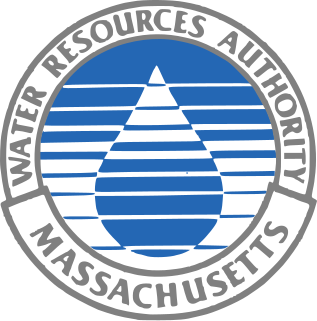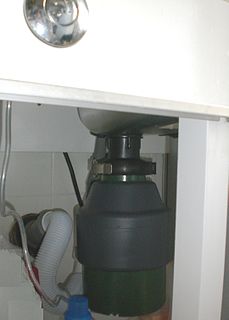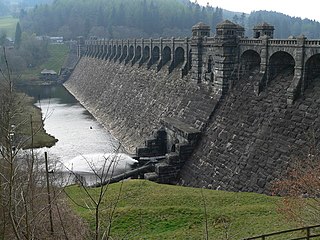An autonomous building is a building designed to be operated independently from infrastructural support services such as the electric power grid, gas grid, municipal water systems, sewage treatment systems, storm drains, communication services, and in some cases, public roads.
Electric power systems consist of generation plants of different energy sources, transmission networks, and distribution lines. Each of these components can have environmental impacts at multiple stages of their development and use including in their construction, during the generation of electricity, and in their decommissioning and disposal. These impacts can be split into operational impacts and construction impacts. The United States Environmental Protection Agency clearly states that all forms of electricity generation have some form of environmental impact. The European Environment Agency view is the same. This page looks exclusively at the operational environmental impact of electricity generation. The page is organized by energy source and includes impacts such as water usage, emissions, local pollution, and wildlife displacement.
The Boston Water and Sewer Commission (BWSC) serves retail customers with water services in Boston, Massachusetts. It purchases water wholesale from the Massachusetts Water Resources Authority (MWRA).

The Massachusetts Water Resources Authority (MWRA) is a public authority in the Commonwealth of Massachusetts that provides wholesale drinking water and sewage services to certain municipalities and industrial users in the state, primarily in the Boston area.

Boston Harbor is a natural harbor and estuary of Massachusetts Bay, and is located adjacent to the city of Boston, Massachusetts. It is home to the Port of Boston, a major shipping facility in the northeastern United States.
Sewage disposal regulation and administration describes the governance of sewage treatment and disposal.

District heating is a system for distributing heat generated in a centralized location through a system of insulated pipes for residential and commercial heating requirements such as space heating and water heating. The heat is often obtained from a cogeneration plant burning fossil fuels or biomass, but heat-only boiler stations, geothermal heating, heat pumps and central solar heating are also used, as well as heat waste from factories and nuclear power electricity generation. District heating plants can provide higher efficiencies and better pollution control than localized boilers. According to some research, district heating with combined heat and power (CHPDH) is the cheapest method of cutting carbon emissions, and has one of the lowest carbon footprints of all fossil generation plants.

A garbage disposal unit is a device, usually electrically powered, installed under a kitchen sink between the sink's drain and the trap. The disposal unit shreds food waste into pieces small enough—generally less than 2 mm (0.079 in) in diameter—to pass through plumbing.

Icon Water Limited, trading principally as Icon Water, is a water and wastewater public utility that is an Australian Capital Territory-owned corporation. The company provides drinking water and wastewater services to the ACT. Icon Water is also a 50% owner of ActewAGL, a multi-utility provider of electricity and gas services in the ACT and south-east New South Wales. Icon Water Limited is also the owner of Bendora Dam, Corin Dam, Cotter Dam and Googong Dam in New South Wales. Water is gravity fed to Canberra via the Bendora Gravity Main and pumped from Googong Dam. Icon Water operates, and maintains 50 service reservoirs, 25 pump stations, 2 water treatment plants, 27 sewage pumping stations, 4 sewage treatments plants, over 3,400 km of sewer pipelines and over 3,400 km of water pipelines.
The utility infrastructure of London, England comprises a range of services and facilities that support and enable the functioning of London as a world city. Infrastructure includes facilities associated with products and materials that are consumed such as electricity, gas, water, heating and liquid fuels; materials that are produced such as sewage and solid waste; and facilities that enable communication and connectivity – telecommunications.

Moon Island is an island in Quincy Bay, in the middle of Boston Harbor, Massachusetts. It is the location of the Boston Fire Department Training Academy, and Boston Police Department shooting range. All of the land on the island is owned by the City of Boston but the island is under the jurisdiction of Quincy, Massachusetts. It is also part of the Boston Harbor Islands National Recreation Area.
Water supply and sanitation in the United States involves a number of issues including water scarcity, pollution, a backlog of investment, concerns about the affordability of water for the poorest, and a rapidly retiring workforce. Increased variability and intensity of rainfall as a result of climate change is expected to produce both more severe droughts and flooding, with potentially serious consequences for water supply and for pollution from combined sewer overflows. Droughts are likely to particularly affect the 66 percent of Americans whose communities depend on surface water. As for drinking water quality, there are concerns about disinfection by-products, lead, perchlorates, PFAS and pharmaceutical substances, but generally drinking water quality in the U.S. is good.
Public water supply and sanitation in England and Wales has been characterised by universal access and generally good service quality. Salient features of the sector in the United Kingdom compared to other developed countries is the full privatisation of service provision and the pioneering of independent economic regulation in the sector in Europe. There has been a substantial increase in real tariffs between 1989 and 2005, whilst independent assessments place the cost of water provision in the UK as higher than most major countries in the EU. The government body responsible for water regulation, together with the water companies, have claimed improvements in service quality during the same period.
The Nut Island effect describes an organizational behavior phenomenon in which a team of skilled employees becomes isolated from distracted top managers resulting in a catastrophic loss of the ability of the team to perform an important mission. The term was coined by Paul F. Levy, a former Massachusetts state official, in an article in the Harvard Business Review published in 2001. The article outlines a situation which resulted in massive pollution of Boston Harbor, and proposes that the name of the facility involved be applied to similar situations in other business enterprises. The work is used as a source in human resources management case studies and is featured on the websites of several business management consulting firms and health care institutions.

The City of Nottingham Water Department (1912–1974), formerly the Nottingham Corporation Water Department (1880–1912), was responsible for the supply of water to Nottingham from 1880 to 1974. The first water supply company in the town was the Nottingham Waterworks Company, established in 1696, which took water from the River Leen, and later from springs at Scotholme, when the river became polluted. Other companies were set up in the late 18th century and in 1824, while in 1826 the Trent Water Company was established. They employed Thomas Hawksley as their engineer, who became one of the great water engineers of the period, and Nottingham had the first constant pressurised water supply system in the country. The various companies amalgamated in 1845, and Hawksley remained as the consulting engineer until 1879.

The history of water supply and sanitation is one of a logistical challenge to provide clean water and sanitation systems since the dawn of civilization. Where water resources, infrastructure or sanitation systems were insufficient, diseases spread and people fell sick or died prematurely.
Chennai Metropolitan Water Supply and Sewerage Board, known shortly as CMWSSB, is a statutory board of Government of Tamil Nadu which provides water supply and sewage treatment to the city of Chennai and areas around it.
Water supply and sanitation in Istanbul is the responsibility of the public utility ISKI created in 1981.
Earle Bernard Phelps was a chemist, bacteriologist and sanitary expert who served in governmental positions and as an academic in some of the leading universities in the U.S. He is known for his contributions in sewage disinfection, water chlorination, sewage treatment, milk pasteurization, shellfish control, and for describing the “oxygen sag curve” in surface water bodies.

Liverpool Corporation Waterworks and its successors have provided a public water supply and sewerage and sewage treatment services to the city of Liverpool, England. In 1625 water was obtained from a single well and delivered by cart, but as the town grew, companies supplied water to homes through pipes. There were two main companies by the 1840s, but the water supply was intermittent, and there was general dissatisfaction with the service. Liverpool Corporation decided that such an important service should be provided by a public body, and sought to take over the water supply companies.









